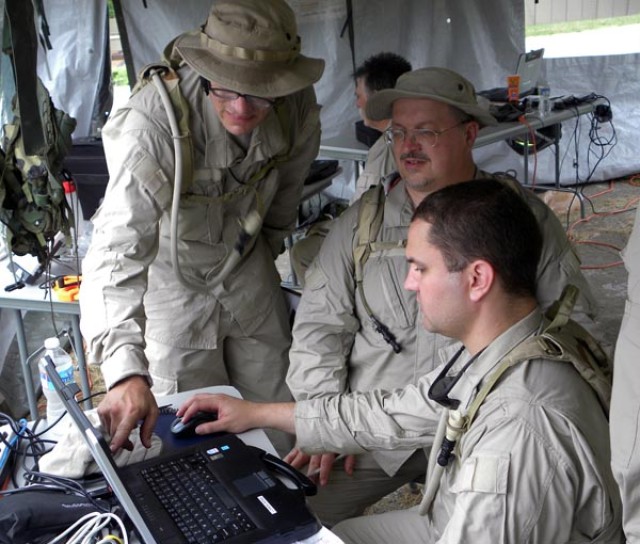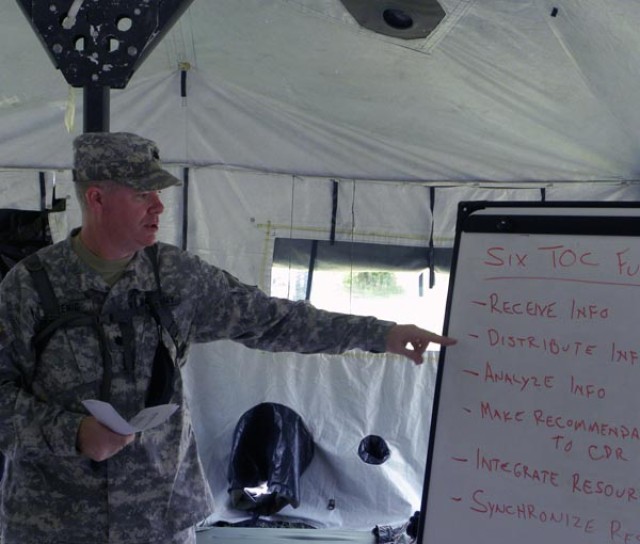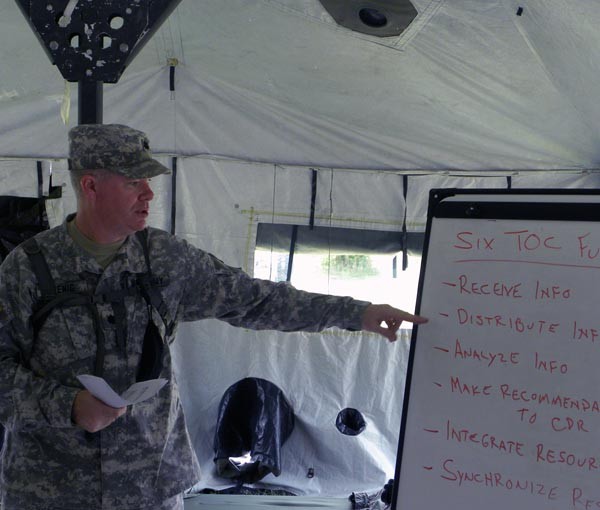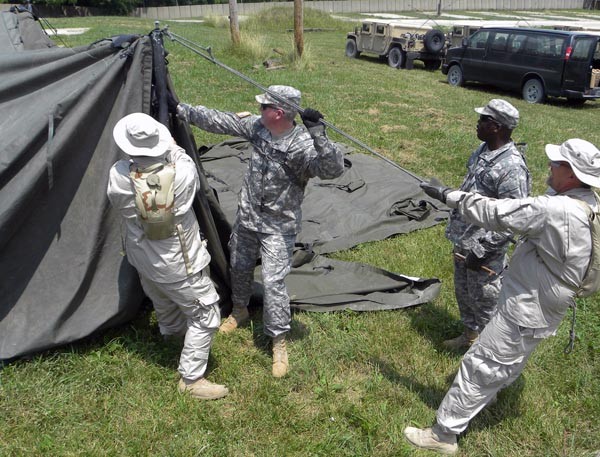FORT KNOX, Ky. - The U.S. Army Corps of Engineers (USACE) specialists of the 533rd Engineer Detachment, Forward Engineer Support Team - Main (FEST-M) tested their individual and technical capabilities during a predeployment field training exercise June 23-25.
The 533rd FEST-M is an expeditionary unit staffed with about three civilian specialists for each Soldier assigned. The unit's mission in theater is to provide contract construction and engineering execution in support of military operations and requires a team equipped and trained on advanced USACE technical communication tools and Army technical, organizational and operational skills.
Most of the unit's Soldiers deployed last June in support of Operation Iraqi Freedom. While they were deployed, the staff members still at Fort Knox trained on the equipment and operational skills they will need to conduct advanced tactical operations training when the Soldiers rejoin them in August.
"We've worked hard over the past year to master a wide variety of individual training tasks on both the Army and Corps side," said Lt. Col. Douglas Hoenig, executive officer. "In this exercise, we are leaving the crawl stage of training - the mastering of our individual tasks - and entering as a team into the walk stage where we put it all together and establish a base of operations in an austere environment."
The team was given four main tasks to complete: convoy and set-up of a tactical operation center (TOC), conduct an airfield assessment to support simultaneous helicopter landings, create a 100-person base camp expansion design, and establish a satellite video teleconference link to conduct a mock command brief.
To John Oberhelman, mechanical engineer and range officer in charge for this exercise, doing what sounded easy in the classroom - gear up, convoy to the field, set up a tent and establish communication with the home office - was a much bigger logistical challenge than he expected.
"Just to be here in the training area took weeks of coordination," Oberhelman said. "We had to get several people certified as range control officers to ensure the safety of our unit. We also needed someone trained as a combat life saver, another to identify unexploded ordnance and range markers, and another to conduct risk assessments. Everything has to be documented and verified. I'm amazed at the amount of coordination, planning and training that has to happen before we even leave the motor pool."
As the team arrived on site, Oberhelman coordinated unloading and setup of the tactical operations center (TOC). As the last table and chair was put in place, Hoenig setup a whiteboard and the group discussed required TOC functions.
"The TOC serves as the unit's command and control hub," said Hoenig. "It's where most of the unit planning and coordination occurs and it has to be outfitted with the right personnel and equipment so the commander can be kept up to date on key events and missions."
With minimal prompting from Hoenig, the team determined what functions the TOC had to support and then collectively set up shop. With day two in mind, day one wrapped up a success.
On day two, they set up internet communications and began the assessment data collection process. It was the first time this team conducted assessments in a tactical training environment.
"When I planned my engineering career, I never pictured myself out in the field in full body armor," said Loren Ross, civil engineer. "It's heavy and it's hot, but it's also one of the reasons I pursued working for the FEST-M. In the office I can study images on Google Earth and design a general base camp - here in the field, I get a whole new perspective."
Ross says the team benefited most from the hands-on aspect of the exercise.
"Being on-site allows us to collaborate in a way we can't do in the office," Ross said. "Walking the terrain with the intelligence and logistics officers, I can see certain details of the design requirements in a new way. Even though we are looking at the same terrain and infrastructure, we interpret its value differently based on our knowledge, experience and area function requirements. The end result is a much better design."
By midmorning on day three, the team put the final touches on their assessments and presented their products in standard Army command brief format to staff members via a satellite video teleconference link with the office at Fort Knox.
After the briefing, the team received feedback from senior leadership on their performance.
"The team did a great job for their first exercise of this type," said Master Sgt. Regenal McGriff, exercise operations sergeant. "The mistakes they made were anticipated and necessary. We want the mistakes to be made here and not when we are under the pressure of a real-world mission. The next step is to review the team's strengths and work on weaknesses."
Training will be more challenging next month when the Soldiers will reintegrate with the unit.
"When the team is finally all together we will enter the run stage of collective training of assessment teams, tracking and monitoring missions and specific deployment training," said Hoenig. "It's going to be a challenge, but it's one this team is ready for."








Social Sharing